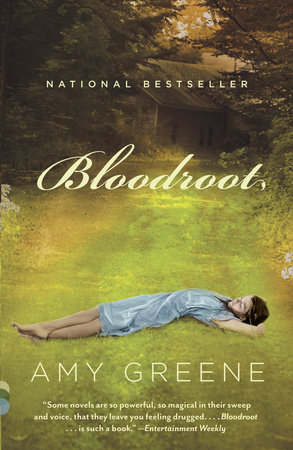Reading Group Center
- Home •
- Books by Category •
- Imprints •
- News •
- Videos •
- Media Center •
- Reading Group Center
Amy Greene Chooses Three Books About Mothers and Daughters
Bloodroot is a novel full of family—several generation’s worth of characters, each with their own perspective, but united by their blood ties to each other and to the Appalachian country around them. The women of Bloodroot often become mothers at a young age, and those with daughters learn that the familial bonds between women can be as tense as they are loving. In the essay below, author Amy Greene discusses several novels that also explore this complex mother/daughter bond.
Is writing therapy? Some say it is. I’m not so sure. What I do know is that I’ve confronted some of my worst fears as a parent in the pages of my novels. I’m certainly not the first woman to have explored motherhood in fiction. As a child one of my favorite books was Little Women by Louisa May Alcott. Marmee was the perfect maternal figure, with her gentle guidance and her unconditional love for her daughters. But in contemporary literature, motherhood is less idealized: daughters are abandoned, like Bone in Dorothy Allison’s Bastard Out of Carolina. Mothers sell their daughters to black market adoption agencies, like Petal in Annie Proulx’s The Shipping News. Many of my favorite authors are mothers as well as daughters, and their sometimes autobiographical novels reflect their conflicting feelings about both roles. These three books shed even more light on one of the most significant relationships in every woman’s life.
The Dollmaker by Harriette Arnow. In Harriette Arnow’s 1954 novel The Dollmaker, Gertie Nevels moves with her family from Kentucky to Detroit, where her husband has found work. Leaving the freedom of the mountains for the confinement of the city threatens to break the spirit of her little girl Cassie. Gertie has a special bond with Cassie, maybe because she recognizes the responsibility of raising such a sensitive and precocious child. She’s burdened with guilt when she follows her husband to Michigan out of economic necessity, even knowing Cassie isn’t likely to thrive in the slums of Detroit. When Cassie suffers a horrible accident, Gertie blames herself. But with the rest of her brood to consider, she doesn’t have the luxury of falling apart. While the book’s outcome is more complex than the happy ending I was hoping for, it seems fitting that Gertie’s story resolves with a sacrifice for her children. It’s clear from the first pages that they’re the focus of her life. Like any mother, she has to do what she believes is right for her kids.
The Tiny One by Eliza Minot. At seven years old, Eliza Minot lost her mother to a car accident. Her autobiographical novel The Tiny One is a retelling of the day the narrator Via Revere’s mother, referred to only as “Mum,” dies the same way. Every detail is remembered, from the cereal Via eats for breakfast to the moment she’s called to the principal’s office to be told the news. Interspersed among the details are memories of the short time Via had with Mum, vignettes like windows into the sweet, uncomplicated relationship between a daughter and her mother before adolescence. It’s a testament to Eliza Minot’s skill, and to the power of fiction, that I was so immersed in her story it gave me nightmares. I dreamed of a smaller version of myself coming home from school as Via does to a houseful of relatives and the reality that my mother is gone forever, that I’ll grow up without her. The Tiny One prompts readers to contemplate their own mortality. And it makes mothers wonder what our children would do without us if we couldn’t be here to raise them. (Click here to download a reading group guide.)
Monkeys by Susan Minot. Susan Minot is Eliza’s older sister. Her novel Monkeys also centers around their mother’s death in a car accident. The title comes from the group pet name Rosie Vincent gives her seven children, as she provides the glue that holds her household together, struggling to make a secure home while hiding her husband’s alcoholism. It’s insightful to read Monkeys and The Tiny One back to back, since Susan Minot has written a much different novel from her sister’s: Monkeys is a reconstruction of a mother’s life rather than a dissection of her death. It seems that Eliza, the baby of the family, is trying to resurrect in writing the woman she barely knew, while Susan is examining the woman she remembers in order to know her better. As I read, I kept imagining my daughter looking back on my life the same way someday. Sitting down with a book like Monkeys is an intimate experience.
For me, each of these three novels is an invitation to think deeper, to take a closer look at myself. But for other mothers, or daughters, they will mean something else–they’ll give life to their own dreams and memories, and call forth their own particular stories. If writing is therapy, then just maybe, so is reading.
Amy Greene is the author of Bloodroot. Click here to read an excerpt, and click here to download a free reading group guide.


